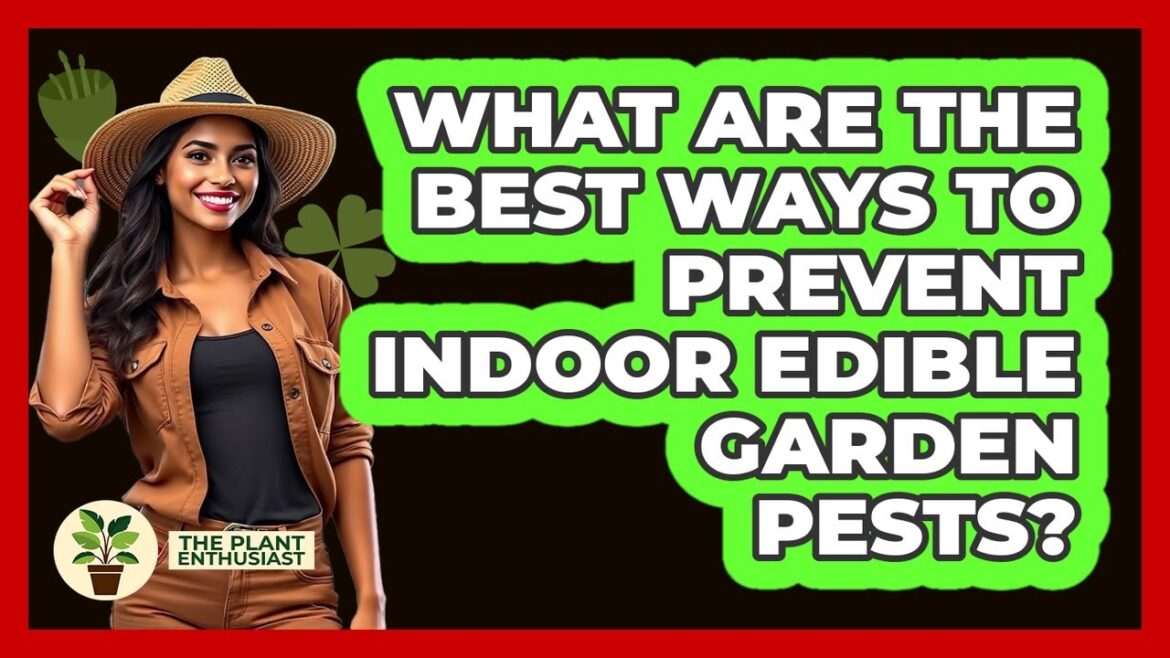What Are The Best Ways To Prevent Indoor Edible Garden Pests? Are pests invading your indoor edible garden? In this helpful video, we’ll share proven strategies to keep pests at bay and maintain a healthy, thriving garden. You’ll learn how to spot early signs of pests, quarantine new plants effectively, and create an environment that discourages unwanted visitors. We’ll discuss the importance of good air circulation, proper watering, and avoiding over-fertilizing, all of which help prevent pest problems. Additionally, you’ll discover natural pest deterrents such as homemade sprays, essential oils, and traps that are safe for your edible plants. We’ll also cover how to handle pest outbreaks quickly with safe treatments like insecticidal soap and neem oil, and the best ways to prevent pests from hitching a ride on new plants brought indoors. Whether you’re growing herbs, vegetables, or decorative plants, these tips will help you protect your indoor garden from common pests. By combining regular inspections, natural deterrents, and good gardening habits, you can keep your plants healthy, productive, and pest-free. If you’re interested in maintaining a lush, pest-free indoor garden, this video is perfect for you. Don’t forget to subscribe for more gardening tips and tricks to help your plants flourish!
⬇️ Subscribe to our channel for more valuable insights.
🔗Subscribe: https://www.youtube.com/@The-Plant-Enthusiast/?sub_confirmation=1
#IndoorGarden #PlantCare #GardenTips #PestControl #OrganicGardening #PlantProtection #HomeGarden #GardeningHacks #EdibleGarden #GardenMaintenance #PlantHealth #NaturalPestControl #IndoorPlants #PlantLovers #GardeningForBeginners
About Us: Welcome to The Plant Enthusiast, your go-to destination for everything related to the wonderful world of plants! Whether you’re a seasoned gardener or just starting your green journey, our channel is dedicated to nurturing your passion for plant care, cultivation, and creativity.
[Music] What are the best ways to prevent indoor edible garden pests? Imagine walking into your indoor garden and seeing healthy, vibrant plants ready to harvest. Now, picture pests sneaking in and causing trouble. Keeping pests out is easier than you think. It all starts with good habits and careful planning. First, always check new plants thoroughly before adding them to your garden. Look for tiny bugs, eggs, or webs. If you see anything suspicious, quarantine the plant in a separate room for at least a week. This way, you catch pests early before they spread. Good air circulation is also key. Space your plants about 6 to 12 in apart and use a small fin to keep air moving. This prevents damp spots where pests love to hide and makes it harder for flying insects to settle. Be careful with fertilizing. Too much fertilizer can stress plants and attract pests like aphids and mites. Use only the amount recommended on the package and avoid overfeeding. Keep your tools clean, too. After trimming or watering, wash your gardening tools with soap and water. This stops pests from hitching a ride from one plant to another. Choose plants that are naturally resistant to pests. For example, herbs like mint, basil, and rosemary are less attractive to bugs. Potted plants like snake plants, jade, and bromeilads are also good options. Natural pest sprays are safe and effective. Mix garlic, a few drops of mild liquid soap, and water in a spray bottle. Spray this mixture on your plants weekly to keep pests away. You can also use essential oils like rosemary, mint, or eucalyptus. These oils are strong enough to repel bugs, but safe for edible plants. If pests appear, act quickly. Isolate the affected plant to prevent spreading. Use insecttoidal soap or neem oil which are safe for food plants. Follow the instructions carefully and spray in the early morning or late evening. For flying pests like fungusnats, set up traps using apple cider vinegar and a few drops of dish soap in a small container. The bugs will be attracted to the vinegar and get caught. When bringing plants inside from outside, wash the sole and leaves thoroughly. Consider replacing the top inch of soil or using fresh soil to remove any hidden eggs or pests. Keep new plants in a separate room for a few days. Watch four signs of pests before adding them to your main garden. Combining these simple steps creates a strong defense against pests. Regular inspections, good airflow, proper watering, and natural deterrence keep your indoor edible garden healthy and productive. Remember, a little prevention goes a long way in making sure your plants stay pestfree and delicious. [Music]


Comments are closed.